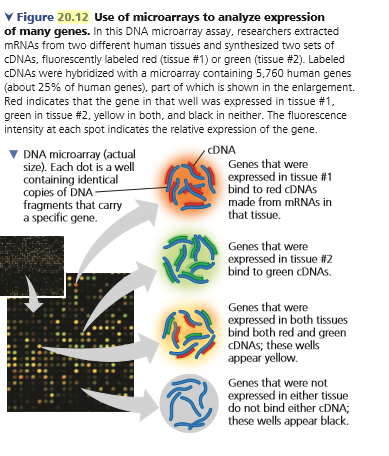V Figure 20.12 Use of microarrays to analyze expression of many genes. In this DNA microarray assay, researchers extracted MRNAS from two different human tissues and synthesized two sets of CDNAS, fluorescently labeled red (tissue #1) or green (tissue #2). Labeled CDNAS were hybridized with a microarray containing 5,760 human genes (about 25% of human genes), part of which is shown in the enlargement. Red indicates that the gene in that well was expressed in tissue #1, green in tissue #2, yellow in both, and black in neither. The fluorescence intensity at each spot indicates the relative expression of the gene. V DNA microarray (actual size). Each dot is a well containing identical copies of DNA fragments that carry a specific gene. DNA Genes that were expressed in tissue #1 bind to red CDNAS made from MRNAS in that tissue. Genes that were expressed in tissue #2 bind to green cDNAs. Genes that were expressed in both tissues bind both red and green CDNAS; these wells appear yellow. Genes that were not expressed in either tissue do not bind either CDNA; these wells appear black.
V Figure 20.12 Use of microarrays to analyze expression of many genes. In this DNA microarray assay, researchers extracted MRNAS from two different human tissues and synthesized two sets of CDNAS, fluorescently labeled red (tissue #1) or green (tissue #2). Labeled CDNAS were hybridized with a microarray containing 5,760 human genes (about 25% of human genes), part of which is shown in the enlargement. Red indicates that the gene in that well was expressed in tissue #1, green in tissue #2, yellow in both, and black in neither. The fluorescence intensity at each spot indicates the relative expression of the gene. V DNA microarray (actual size). Each dot is a well containing identical copies of DNA fragments that carry a specific gene. DNA Genes that were expressed in tissue #1 bind to red CDNAS made from MRNAS in that tissue. Genes that were expressed in tissue #2 bind to green cDNAs. Genes that were expressed in both tissues bind both red and green CDNAS; these wells appear yellow. Genes that were not expressed in either tissue do not bind either CDNA; these wells appear black.
Human Anatomy & Physiology (11th Edition)
11th Edition
ISBN:9780134580999
Author:Elaine N. Marieb, Katja N. Hoehn
Publisher:Elaine N. Marieb, Katja N. Hoehn
Chapter1: The Human Body: An Orientation
Section: Chapter Questions
Problem 1RQ: The correct sequence of levels forming the structural hierarchy is A. (a) organ, organ system,...
Related questions
Concept explainers
Question
Consider the microarray in Figure 20.12. If a sample from normal tissue is labeled with a green fluorescent dye and a sample from cancerous tissue is labeled red, what color spots would represent genes you would be interested in if you were studying cancer? Explain.

Transcribed Image Text:V Figure 20.12 Use of microarrays to analyze expression
of many genes. In this DNA microarray assay, researchers extracted
MRNAS from two different human tissues and synthesized two sets of
CDNAS, fluorescently labeled red (tissue #1) or green (tissue #2). Labeled
CDNAS were hybridized with a microarray containing 5,760 human genes
(about 25% of human genes), part of which is shown in the enlargement.
Red indicates that the gene in that well was expressed in tissue #1,
green in tissue #2, yellow in both, and black in neither. The fluorescence
intensity at each spot indicates the relative expression of the gene.
V DNA microarray (actual
size). Each dot is a well
containing identical
copies of DNA
fragments that carry
a specific gene.
DNA
Genes that were
expressed in tissue #1
bind to red CDNAS
made from MRNAS in
that tissue.
Genes that were
expressed in tissue #2
bind to green cDNAs.
Genes that were
expressed in both tissues
bind both red and green
CDNAS; these wells
appear yellow.
Genes that were not
expressed in either tissue
do not bind either CDNA;
these wells appear black.
Expert Solution
This question has been solved!
Explore an expertly crafted, step-by-step solution for a thorough understanding of key concepts.
This is a popular solution!
Trending now
This is a popular solution!
Step by step
Solved in 2 steps

Knowledge Booster
Learn more about
Need a deep-dive on the concept behind this application? Look no further. Learn more about this topic, biology and related others by exploring similar questions and additional content below.Recommended textbooks for you

Human Anatomy & Physiology (11th Edition)
Biology
ISBN:
9780134580999
Author:
Elaine N. Marieb, Katja N. Hoehn
Publisher:
PEARSON

Biology 2e
Biology
ISBN:
9781947172517
Author:
Matthew Douglas, Jung Choi, Mary Ann Clark
Publisher:
OpenStax

Anatomy & Physiology
Biology
ISBN:
9781259398629
Author:
McKinley, Michael P., O'loughlin, Valerie Dean, Bidle, Theresa Stouter
Publisher:
Mcgraw Hill Education,

Human Anatomy & Physiology (11th Edition)
Biology
ISBN:
9780134580999
Author:
Elaine N. Marieb, Katja N. Hoehn
Publisher:
PEARSON

Biology 2e
Biology
ISBN:
9781947172517
Author:
Matthew Douglas, Jung Choi, Mary Ann Clark
Publisher:
OpenStax

Anatomy & Physiology
Biology
ISBN:
9781259398629
Author:
McKinley, Michael P., O'loughlin, Valerie Dean, Bidle, Theresa Stouter
Publisher:
Mcgraw Hill Education,

Molecular Biology of the Cell (Sixth Edition)
Biology
ISBN:
9780815344322
Author:
Bruce Alberts, Alexander D. Johnson, Julian Lewis, David Morgan, Martin Raff, Keith Roberts, Peter Walter
Publisher:
W. W. Norton & Company

Laboratory Manual For Human Anatomy & Physiology
Biology
ISBN:
9781260159363
Author:
Martin, Terry R., Prentice-craver, Cynthia
Publisher:
McGraw-Hill Publishing Co.

Inquiry Into Life (16th Edition)
Biology
ISBN:
9781260231700
Author:
Sylvia S. Mader, Michael Windelspecht
Publisher:
McGraw Hill Education